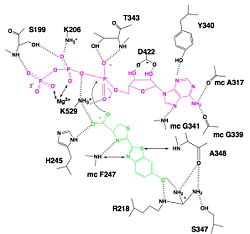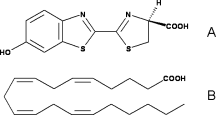Sandbox Reserved 951
From Proteopedia
(Difference between revisions)
| Line 4: | Line 4: | ||
Firefly, also named Photinus pyralis, is a bioluminescent insect. They are able to produce light by an energetic process, in order to attract its mate. The enzyme responsible of this light producing is luciferase, also known as luciferin-4-monooxygenase (EC: 1.13.12.7). It acts also as a ligase. This enzyme has various applications in the biotechnology field. In fact, it is used in chemical biology and drug trials. As there is no light production by mammals, luciferase is really a great tool for researchers. But this light emission depends on the environmental conditions. For example, they help to detect protein-protein interactions, to track cells in vivo in order to analysis the development of disease at the molecular level in real-time , to monitor the transcriptional and post-transcriptional regulation of specific gens, to control apoptosis, to label cancer cells, to detect environmental contaminations … <ref>PMID: 15722018</ref> | Firefly, also named Photinus pyralis, is a bioluminescent insect. They are able to produce light by an energetic process, in order to attract its mate. The enzyme responsible of this light producing is luciferase, also known as luciferin-4-monooxygenase (EC: 1.13.12.7). It acts also as a ligase. This enzyme has various applications in the biotechnology field. In fact, it is used in chemical biology and drug trials. As there is no light production by mammals, luciferase is really a great tool for researchers. But this light emission depends on the environmental conditions. For example, they help to detect protein-protein interactions, to track cells in vivo in order to analysis the development of disease at the molecular level in real-time , to monitor the transcriptional and post-transcriptional regulation of specific gens, to control apoptosis, to label cancer cells, to detect environmental contaminations … <ref>PMID: 15722018</ref> | ||
| - | |||
Thus, this oxydo-reductase is involved in severals reactions. | Thus, this oxydo-reductase is involved in severals reactions. | ||
=====Light emission===== | =====Light emission===== | ||
| - | + | The most known reaction of luciferase is the light emission. In this reaction, luciferase firstly synthetized luciferin-AMP from luciferin and ATP, using a Mg2+ ion to offset the negative charges of the phosphate groups. Then, luciferase turns the luciferin-AMP into oxyluciferin in an excited state thanks to a dioxygen. This step releases AMP and CO2. The excited oxyluciferin relaxes and looses a photon, so light is emitted. | |
| - | The wavelength of the light can vary with the pH : at the physiological pH, the emitted light is green and at a lower pH, the color is red. | + | The wavelength of the light can vary with the pH : at the physiological pH, the emitted light is green and at a lower pH, the color is red.<ref name =''first''>PMID:8805533</ref> |
=====Fatty-acyl-CoA synthesis===== | =====Fatty-acyl-CoA synthesis===== | ||
This reaction uses similar reaction but instead of taking luciferin as ligand, it takes fatty acids. Using ATP-Mg2+, it firstly forms fatty-acyl-AMP. And then, CoA-SH attacks the carboxylic group of fatty-acyl-AMP and so forms fatty-acyl-CoA. | This reaction uses similar reaction but instead of taking luciferin as ligand, it takes fatty acids. Using ATP-Mg2+, it firstly forms fatty-acyl-AMP. And then, CoA-SH attacks the carboxylic group of fatty-acyl-AMP and so forms fatty-acyl-CoA. | ||
| Line 17: | Line 16: | ||
== Global Structure == | == Global Structure == | ||
| - | Luciferase is a 62kDa protein | + | Luciferase is a 62kDa protein and contains 550 amino acids. This enzyme can be divide into two domains. On the one hand, the major portion, corresponding to the <scene name='60/604470/N_terminal_domain/1'>N-terminal</scene>. On the other hand, the small portion, corresponding to the <scene name='60/604470/C_terminal_domain/1'>C-terminal domain</scene>.Those two domains are separated by a large cleft.<ref name =''first''>PMID:8805533</ref> |
| - | ====The C terminal domain==== | + | ====The C-terminal domain==== |
| - | The amino acids of C terminal | + | The sequence of amino acids of C-terminal domain is composed of contiguous residues and forms a type of lid upon the N-terminal domain. It contains two β sheets: the <scene name='60/604470/Beta_sheet/2'>first β sheet </scene> is composed of two short antiparallel strands and the <scene name='60/604470/Beta_sheet_2/1'> second β sheet</scene> is composed of 3 antiparallel strands, mixed with <scene name='60/604470/3_alpha_helices/1'>three α helices</scene>. Those helices are put toward the outside. It is α + β structure.<ref name =''second''>PMID:8805533</ref> |
| - | ====The N terminal domain==== | + | ====The N-terminal domain==== |
| - | The amino acids of C terminal | + | The sequence of amino acids of C-terminal domain is composed of non-contiguous residues. It falls into three subdomains (<scene name='60/604470/Domain_a/1'>the subdomain A</scene>,<scene name='60/604470/Domain_b/1'>the subdomain B</scene>, and <scene name='60/604470/Domain_c/1'>the subdomain C</scene>). The subdomains A and B corresponds to two β sheets, which are framed by <scene name='60/604470/Alpha_helices/1'>α helices</scene>. The subdomain C is an antiparallel <scene name='60/604470/Beta_barrel/3'>β barrel</scene>. Each of the two β sheets subdomains are composed of 8 β strands and 6 helices. The β sheet A has <scene name='60/604470/A_beta_strands/1'>5 parallel and 3 antiparallel β strands</scene>. The β sheet B has <scene name='60/604470/A_beta_strands/1'>6 parallel and 2 antiparallel β strands</scene>. Those β sheets create a groove, closed on one end by the β barrel.<ref name =''third''>PMID:8805533</ref> |
Revision as of 12:02, 9 January 2015
| |||||||||||
References
- ↑ Welsh DK, Kay SA. Bioluminescence imaging in living organisms. Curr Opin Biotechnol. 2005 Feb;16(1):73-8. PMID:15722018 doi:http://dx.doi.org/10.1016/j.copbio.2004.12.006
- ↑ 2.0 2.1 2.2 2.3 2.4 2.5 2.6 Conti E, Franks NP, Brick P. Crystal structure of firefly luciferase throws light on a superfamily of adenylate-forming enzymes. Structure. 1996 Mar 15;4(3):287-98. PMID:8805533
- ↑ Marques SM, Esteves da Silva JC. Firefly bioluminescence: a mechanistic approach of luciferase catalyzed reactions. IUBMB Life. 2009 Jan;61(1):6-17. PMID:18949818 doi:10.1002/iub.134
- ↑ Photobiology
- ↑ Photobiology
- ↑ Photobiology
- ↑ Marques SM, Esteves da Silva JC. Firefly bioluminescence: a mechanistic approach of luciferase catalyzed reactions. IUBMB Life. 2009 Jan;61(1):6-17. PMID:18949818 doi:10.1002/iub.134
- ↑ Hosseinkhani S. Molecular enigma of multicolor bioluminescence of firefly luciferase. Cell Mol Life Sci. 2011 Apr;68(7):1167-82. doi: 10.1007/s00018-010-0607-0. Epub, 2010 Dec 28. PMID:21188462 doi:http://dx.doi.org/10.1007/s00018-010-0607-0
- ↑ Inouye S. Firefly luciferase: an adenylate-forming enzyme for multicatalytic functions. Cell Mol Life Sci. 2010 Feb;67(3):387-404. Epub 2009 Oct 27. PMID:19859663 doi:10.1007/s00018-009-0170-8


